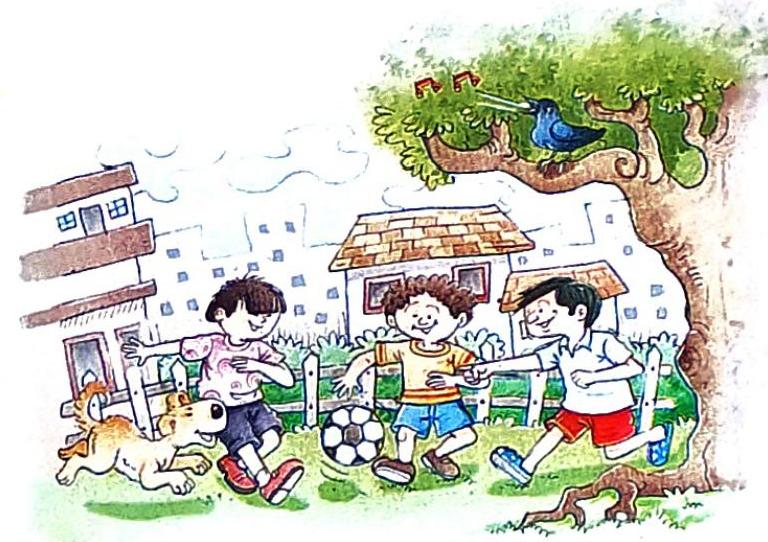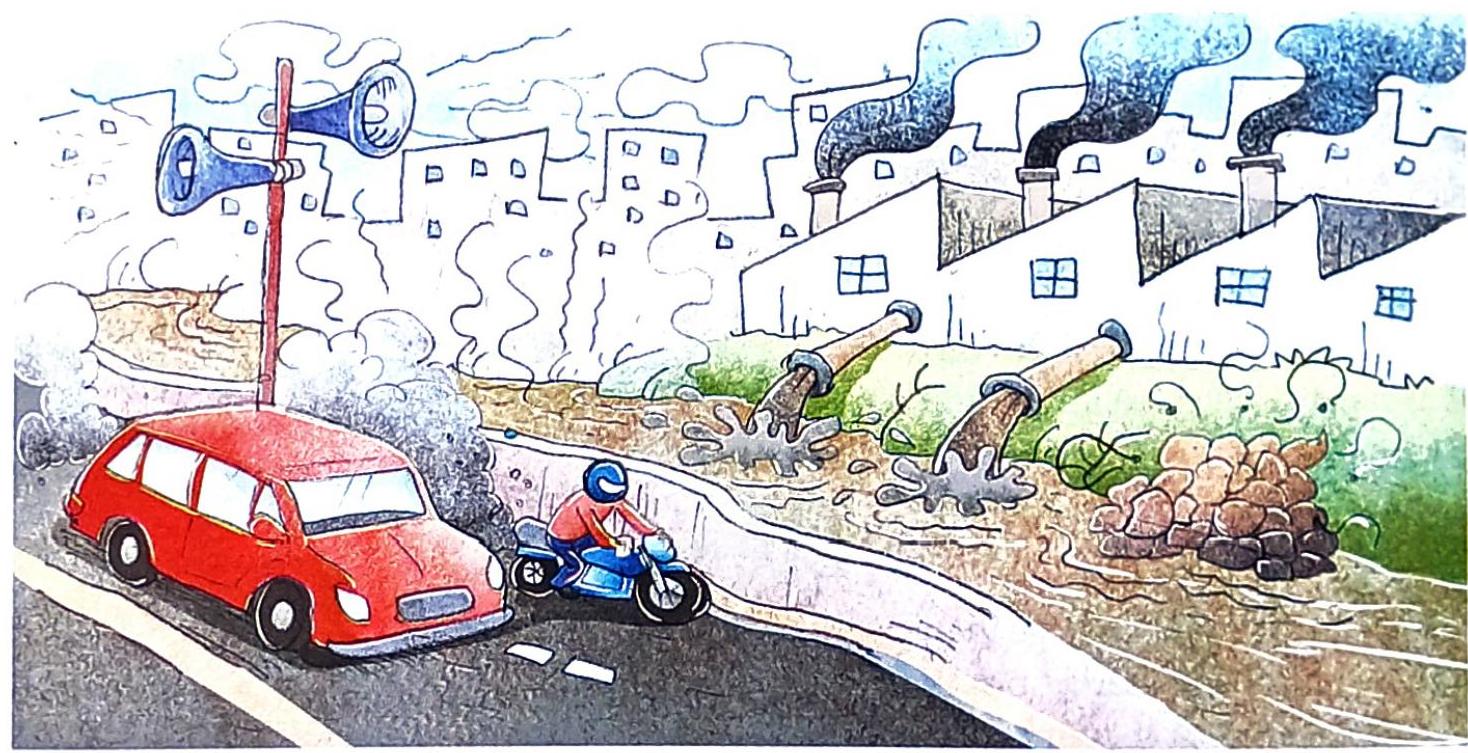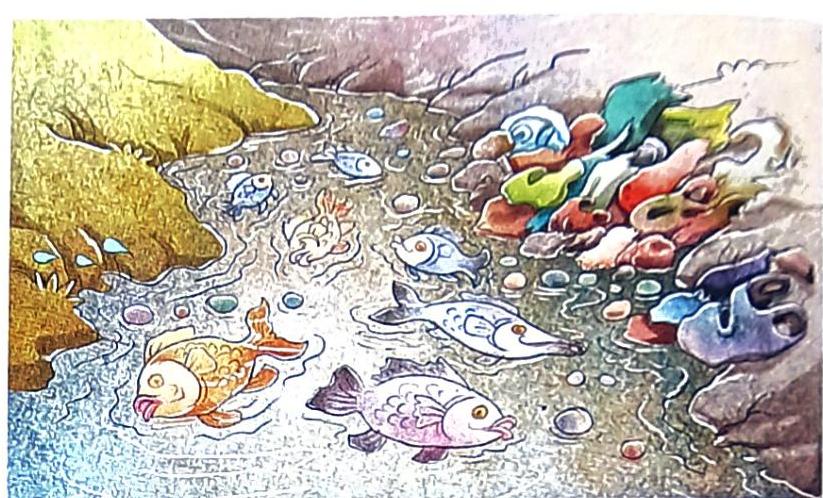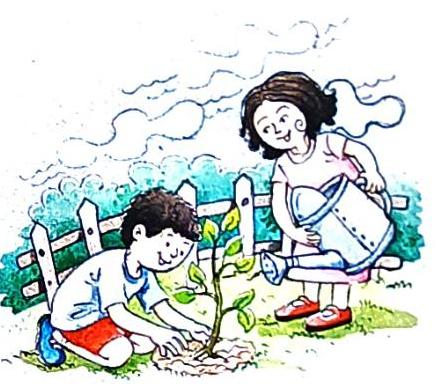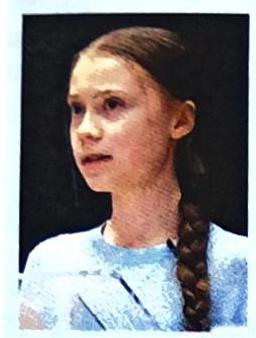Chapter: 18. The Environment
The Environment: A Self-Study Guide
A Journey to Understand and Protect Our Planet
1. Understanding Our Environment
Our environment is everything around us. This includes ourselves, our homes, the plants, animals, air, water, and the land. It is vital because it provides us with everything we need to live:
Water for drinking and daily activities Heat, light, and energy for our comfort and needs Our environment is incredibly important, and we all have a role in taking good care of it.
Key Terms to Remember
To better understand our environment and how to protect it, let’s learn some important words:
Environment: Everything around us, including living things (like humans, animals, plants) and non-living things (like air, water, land, heat, light, and energy). Pollution: When harmful materials make our environment dirty and unhealthy. Air Pollution: When the air becomes dirty with smoke and harmful gases. Water Pollution: When water bodies like rivers, lakes, and oceans become dirty with waste. Land Pollution: When the land we live on becomes dirty with garbage and waste. Noise Pollution: Unwanted, loud, and unpleasant sounds that disturb people and animals. Conservation: The act of taking care of our Earth and its natural resources, including air, water, animals, plants, and humans.
2. What Harms Our Environment?
We, as humans, are a significant part of the environment. However, many of our actions can cause changes that harm the environment, which then affects us too.
Here are some examples of how our actions can harm the environment:
Air Getting Dirty: Dust and smoke from vehicles like cars and buses, as well as from factories, release harmful substances into the air. Water Getting Dirty: Waste from our homes and factories is often thrown into rivers, lakes, and seas, making the water dirty and unsafe. Land Getting Dirty: Garbage and litter left scattered around make the land dirty and unsightly. FactPedia: Did you know that animals do not like the sound of firecrackers or thunder? Loud noises can scare them and disturb their peace.
3. Pollution: When Things Get Dirty
Pollution happens when harmful materials are released into the environment, making it dirty and unhealthy. Most pollution occurs because of human activities.
There are different kinds of pollution that affect various parts of our environment:
3.1. Air Pollution
Air pollution occurs when smoke and poisonous gases are released into the air. These harmful substances come from:
Burning of wood, coal, or other materials Things that pollute the air are called pollutants. When the air becomes dirty with pollutants, it becomes unhealthy for us to breathe. We need clean and fresh air for our health. Breathing in dirty air can make us sick. Air pollution also makes the air hotter, which increases the Earth’s overall temperature.
FactPedia: The Swachh Bharat Abhiyaan programme was launched on October 2, 2014, to achieve Mahatma Gandhi’s vision of a ‘Clean & Hygienic India’. Its goals include providing toilets in every home and school and making the nation free of garbage.
3.2. Water Pollution
Water pollution happens when waste is released into water bodies such as seas, oceans, rivers, and ponds.
Sources of Waste: Factories and homes often release their waste directly into water bodies. Other Causes: Washing clothes, bathing animals in the water, and throwing trash into water bodies also contribute significantly to water pollution. Oil Spills: Sometimes, large amounts of oil spill into oceans, which is extremely harmful. An oil spill is when oil accidentally leaks into the ocean, often from ships or offshore drilling, causing widespread harm to marine life and coastal environments. Effects of Water Pollution:
Polluted water is unfit and unsafe for drinking. Oil spills make the water very harmful for sea animals and plants, often leading to their death.
3.3. Land Pollution
Land pollution occurs when the land we live on becomes dirty with waste.
Sources of Waste: We produce a lot of garbage in our homes, offices, and market places. This includes items like plastic bags, metal containers, and glass pieces. Impact on Land: When these items are left on the soil, they cause land pollution. Impact on Farming: Land pollution also makes the land unfit for farming, reducing our ability to grow food. Impact on Groundwater: Too much waste on the land can also affect the groundwater beneath it, leading to water pollution as harmful substances seep into the water supply.
3.4. Noise Pollution
Noise pollution is caused by loud, unwanted, and unpleasant noise.
Loud music or loudspeakers Effect: This kind of noise can be very disturbing to humans and animals alike. We should always be careful not to make too much noise that might disturb others around us.
4. Conservation of the Environment
Conservation of the environment means actively taking care of our Earth. This includes protecting and preserving:
And, of course, humans, as we are all interconnected. 4.1. What You Can Do to Save the Environment (Our Duty)
We all have a duty to protect and take care of our environment. This is important so that plants and animals are not negatively affected by human activities. Here are some actions you can take:
Plant Trees: Trees help clean the air by absorbing carbon dioxide and releasing oxygen.
Reduce Vehicle Use: Cars and other vehicles release poisonous gases. For short distances, walk or use a bicycle. For longer trips, consider carpooling or using buses. Keep Surroundings Clean: Always dispose of waste properly in dustbins and ensure your surroundings are garbage-free. Avoid Plastic Bags: Plastic bags cause a lot of land pollution. Use cloth bags for shopping instead. Use Resources Carefully: Be mindful when using water, paper, and electricity. Save Water: Turn off the tap when not in use. Instead of long shower baths, use a bucket to bathe to save water. Proper Waste Disposal: Do not throw garbage and trash on land or into water bodies. Control Noise: Do not play music loudly or make any other loud sounds that disturb others. Avoid Firecrackers: Bursting crackers during festivals creates air and noise pollution. FactPedia: All nations of the world, under the United Nations, have committed to working towards a clean environment and achieving the Sustainable Development Goals (SDG). These goals aim to address global challenges, including those related to our environment.
We celebrate World Environment Day every year in June. It is a special day to remind us all about the importance of protecting our Earth and taking steps to look after it.
4.2. The 3 R’s: A Simple Way to Conserve
The best way to conserve the Earth’s natural resources is to practice the three R’s of conservation: Reduce, Reuse, and Recycle.
Reduce: This means to use less of something. For example, reducing the amount of water you use when brushing your teeth, or reducing the amount of new things you buy. Reuse: This means to use something over and over again instead of throwing it away. For example, reusing a glass jar to store pencils, or refilling a water bottle instead of buying a new one. Recycle: This means to make new items out of used or waste materials. For example, paper, plastic bottles, and metal cans can often be recycled to create new products. 5. People for the Environment: Inspiring Actions
Throughout history, many individuals and groups have worked tirelessly to protect our environment. Here are a couple of inspiring examples:
5.1. The Chipko Movement
When and Where: In the year 1970, in the region of Uttarakhand, India. Who: Villagers, especially women and children, came together. What They Did: They protected forests by locking their arms around trees to prevent them from being cut down for timber. Nature of Movement: This was a non-violent movement, showing that peaceful actions can make a big difference. 5.2. Greta Thunberg
Who: Greta Thunberg is a young Swedish environmental activist. Beginning of Her Movement: In 2018, she started a “School Strike for Climate” by sitting outside the Swedish Parliament with a banner. Global Impact: Slowly, school children across the globe joined her. They started asking their own governments to create laws to control the rising pollution that leads to climate change. International Recognition: She also addressed the UN Climate Action Summit in 2019, bringing global attention to the urgency of climate action. 6. In a Nutshell: Chapter Summary
Let’s recap what we’ve learned about the environment:
Our Environment: Everything around us, including the air, makes up our environment. It provides us with essential resources like oxygen, water, and food. Pollution Defined: Pollution is the presence of harmful things that make our environment dirty and unhealthy. Types of Pollution: There are four main kinds of pollution: Air pollution (dirty air from smoke and gases) Water pollution (dirty water from waste and spills) Land pollution (dirty land from garbage and litter) Noise pollution (loud, unwanted sounds) Conservation: This means taking good care of the Earth’s atmosphere, water, plants, and animals to protect them for the future. The 3 R’s: The most effective way to conserve the Earth’s natural resources is to practice reduce, reuse, and recycle.
 Self Study
Self Study